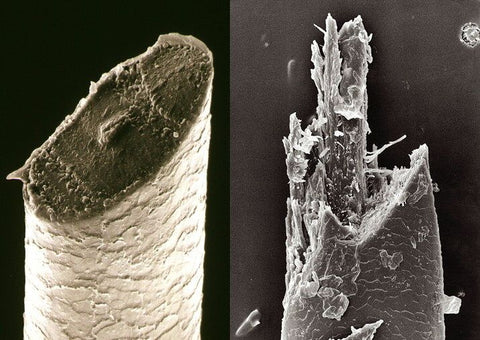
BEARD GROWTH PART ONE: THE BEGINNING
Share
In our previous article, we talked about some general considerations for future beardsmen. If you're reading this, it's because you got through all that, hopefully came away with some useful information, and now you've started your journey.
You've put down the razor. Now it's time to get this show on the road.
THE BEGINNING: THE ITCHING TIMES
For your first couple of days, you're probably not going to see anything that unusual. You've probably gone a day or two without shaving before, so you know you'll start to feel some itch when that stubble starts poking through the skin. That itch is going to be your main concern in the first few days, so let's talk about where that comes from and what you can do about it.

The image above shows two hairs that have been cut. The left one is hair that was cut with a traditional blade, and the right is hair that was cut with an electric razor. While this image is often used to point out why electric shavers are inferior, one thing is true of both hairs: the ends are sharp. The left hair comes to a point with an almost needle-like tip. The right is gnarly and jagged.
Both of those are going to be pretty damn irritating when they are poking through your skin. So whether you've been shaving with a traditional blade or an electric one, you need to do something about that sharp/jagged edge if you want to make your early beard-growth more comfortable.
There are two primary ways to do this: beard oil, and a stubble softener.
A is an invaluable tool in these first days. It lightly abrades the ends of those baby beard hairs to dull that sharp edge. This will go a long way toward making the whole experience more comfortable.
Beard oil is a beardsman's best friend from day one. The oil helps sooth dry skin - and nothing dries skin out like new hair growth. It will also act as a lubricant for those follicles that are dealing with sharp emerging hairs. With less resistance, you'll have less irritation. Our advice is, from the moment you stop shaving - that first day when you look in the mirror, razor in hand, and decide to end the madness and cast that devil-blade away - put some oil on. If you don't have any beard oil yet, slap on a little lotion, or baby oil, whatever you've got. Otherwise, deal with the itch for the time being. But get oil soon. You're always going to need it.
Bonus Suggestion: Get yourself a boar bristle brush, too. The brush is good for distributing oils once your beard has come in, but during the itch phase, it's a great way to sooth that irritating skin. The boar bristles are soft enough to not cause any irritation themselves, but firm enough to scratch that itch.
PHASE TWO: STUBBLE MONSTER
Once the beard has begun to emerge from its face-cocoon, you'll get some relief from that itch. It's important to remember, though, that the itch from new growth is never going to fully go away. Hair grows at different speeds from different follicles due to a million different variables, so even two weeks in you're going to have late blooming hair that is just starting to emerge. Even a two-foot long monster beard is going to have hairs that fall out, come out on your brush or comb, etc. When the follicles start to issue new growth, you're going to have some itch.
That's why beard oil stays so important. It's not just about keeping the hair itself soft and managable. It's about mitigating the iritation beard growth causes to the underbeard skin.
This phase - which is usually a couple of weeks in - is a great time to evaluate your beard's future potential. Think of early stubble as an outline for your beard-in-progress.
Most guys will have hair growing all along the neck, jaw, and up to the cheeks. Many prefer to keep the neck hair cut back, so this will be a good time to start managing that.
If you notice any anomalies, you'll want to start making a plan. Those anomalies are, usually, patchy areas. Places where, even two weeks in, you're still seeing little to no growth. There are a million reasons why patchiness happens, but in general, there's not a lot to be done about it. If you've followed our foundational advice - healthy diet, good exercise, lots of vitamin E and biotin - and you're still patchy, then chances are you're always going to be. And don't go looking for a product that will make your beard grow faster, because it doesn't exist. A patchy beard is something that has to be managed.
The good news is, hair will almost always grow into those patchy areas eventually. The bad news is that it might take a lot longer than you want to wait. No one wants to have an inch of beard growth with a couple of random bald spots. So what do you do?
You can give it time for one. If you're embarrassed to walk around with patchy facial hair, you can try a vacation beard - start growing your beard a week or so before you go on vacation, then let it grow out while you're gone, so that when you come back the growth has started to become more even.
You can also try trimming back the faster growing hair with an electric trimmer (just using a really close guard). The patchiness doesn't look that bad with stubble, while it is a lot more pronounced with the grown hair. Keep the longer growth trimmed back until the patchy areas are able to catch up; your beard is going to come in slower this way, but you can at least do your best to keep that growth even so that it will look better.

But if you patchy growth is particularly dire, or you've got areas that just will not grow hair (such as due to burns, scars, old vampire bites, or just plain genetic mutation), you might need another plan. A lot of guys want to grow a full beard, but the areas that tend to be patchy (cheeks and jaw) often inhibit this plan. Consult a style chart (like the one in this post) and look through the styles that don't have hair growth in the areas that stay bald on you. Can't grow a single whisker on your jawline? Maybe try a goatee, or a Van Dyke. No growth on your chin? Maybe go with a Lemmy-style chopstache. You've got options. Figure out what will work for you and go for it.

